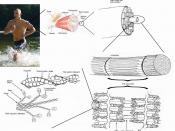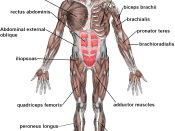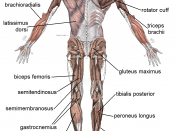In American Scientist journal, "Testing a Muscle's Design," University of Pennsylvania biologist Lawrence C. Rome shows that how a muscular system works depends on macroscopic features, such as the placement of the muscles, as well as microscopic elements, such as the molecular components that make a muscle contract. By examining their characteristics, Rome discovers that many muscular systems perform almost perfectly given their assigned tasks. After a brief introduction to muscle mechanics, examples from frog jumping, fish swimming, and toadfish vocalizing are examined in detail.
Firstly, the structure of the muscle is described at the microscopic level. The author explains that the constituents that make up this structure are muscle cells known as fibers. These fibers consisting of cylindrical myofibrils, contain sarcomeres (2 micrometers long) that are connected end-to-end. Moreover, the structure of the sacromeres consists of myosin and actin, which are thick and thin forms of proteins respectively. Force is generated when projections, called crossbridges, of the thick filament ratchets with thin filaments.
The linear motor-like action, which is created by the force, causes the sarcomeres to shorten. The amount of force generated depends on the length of the sarcomeres. In fact, a short sarcomere would contribute to less force as opposed to a large sarcomere.
Along with his graduate student, Rome studied how muscle cells operate in a moving animal. For their study, a frog's semimembranous was analyzed from a film taken from high-speed motion-picture camera. This study was based on the frog's jump at 200 frames per second, which allowed them to observe the changes in the hip- and knee-joint angles. One factor which a frog's jumping system depends on is optimal sarcomere length. Rome concluded that the length of the sarcomere of a ranid frog actually shortens when it jumps. The total mechanical work, which is...


